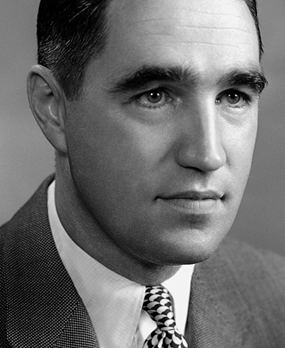Name Earl Wood | ||
 | ||
Died March 18, 2009, Rochester, Minnesota, United States | ||
Earl H. (Howard) Wood, M.D, Ph.D. (c. January 1, 1912 – March 18, 2009) was a cardiopulmonary physiologist who helped invent the G-suit and much more.
Contents
G-Suit
Shortly after receiving an M.D. and PhD in physiology from the University of Minnesota medical school under the mentorship of Professor Maurice B. Visscher, MD, Wood became a key member of a team, working in a, what was then top secret, laboratory at the Mayo Clinic, tasked with helping military pilots and flight crew survive and function in high G-force environments. Based upon extensive physiologic testing via use of the human centrifuge installed at the Mayo Clinic, it was determined that blackout and then unconsciousness was caused by reduction of blood flow to the eyes first and then the brain. The solutions the team arrived at were the M-1 breath hold maneuver and the G-suit. The M-1 maneuver consisted of a strained exhalation effort against a closed glottis designed to increase left ventricular pressure. The G suit was a garment, produced by the David Clark Company, which has air bladders situated at the calves, thighs, and abdomen of the wearer. The bladders inflate as the G-force acting on the aircraft increase, constricting the wearer's arteries, hence increasing blood pressure and blood flow to the brain.
The G-suit was a superior solution to another alternative (a water-filled suit) being tested at the time, which was considered impractically heavy and cumbersome. The water-filled, pulsatile pressure suits were developed to effect venous return. However, Wood and colleagues' detailed physiologic measurements demonstrated that what was required was augmentation of arterial pressure.
Wood himself regularly tested the flight suits, taking many turns in a human centrifuge and plane dubbed the "G-wiz." He calculated that over his several hundred rides, he had lost consciousness for an aggregate of at least fifteen minutes (without any observed lasting damage). Wood was awarded a Presidential Certificate of Merit by Harry Truman in 1947.
The G-suit was adopted in the 1940s. The current models are based on the pattern Wood and his colleagues designed. Following World War II, Wood was recruited to participate in what was known as "Operation Paperclip" The goal was to keep the top German scientists away from Russia and working for the United States.
In 1962, Wood was the tenth scientist to be named "Career Investigator," of the American Heart Association. These funds allowed Wood considerable flexibility in regards to the directions of his research.
Other work
After his work on the G-Suit, Wood worked on techniques for measuring cardiac blood flow. He was granted a patent for the ear oximeter, an optical instrument that measures blood oxygen levels without taking blood by examining the variation of light absorption as a function of oxygen saturation of hemoglobin. Integral to the work leading to the development of the G suit was the perfection of vascular catheterization methods needed to understand the distribution of blood pressure and flow. Shortly after the end of World War II, open-heart surgery emerged with the Mayo contribution to the development of the heart-lung bypass machine initially developed by Gibbons and perfected by Wood and colleagues. Wood's work at the Mayo Clinic lead to the development of many technologies allowing for the assessment of the heart and lungs including dye dilution methods serving to characterize cardiac output, methods for the assessment of central blood volume, the calculation of pulmonary vascular resistance (known as the "Wood Unit" and calculated by subtracting pulmonary capillary wedge pressure from the mean pulmonary arterial pressure and dividing by the cardiac output), analog subtraction angiography, and eventually the Dynamic Spatial Reconstructor (DSR), a predecessor to modern high speed volumetric computed tomography (CT) allowing for the evaluation of the beating heart and breathing lungs. The DSR comprised 14 X-ray tubes and a hemicylindrical fluorescent screen imaged by 14 associated television cameras.
In all, Wood is noted for his contributions (together with members of the Biodynamics Research Unit (BRU), under his direction, within the Physiology and Biophysics Department at the Mayo Clinic) in the following areas:
Wood's publication list, with more than 700 entries, is a testament to the number of fellows who trained under him and who became prominent researchers in their own right.
Early life
Earl Wood was born to Inez Goff and William Clark Wood in Mankato, Minnesota on January 1, 1912 and started life on a subsistence farm. William Wood, in addition to farming, was a real estate businessman. Earl Wood earned a B.A. in Mathematics and Chemistry from Macalester College in 1934, and his MD degree and a PhD degree in physiology from the University of Minnesota. Earl was one of 5 brothers (Earl, Chester, Delbert, Harland and Abe) and a sister, Louise.
Family
All of Earl Wood's siblings grew up to be highly accomplished. Louise A. Wood was awarded the Medal of Freedom by President Truman for her services as over-seas director of the American Red Cross during World War II. and became the executive director of the Girl Scouts of the USA from 1961-1972. Harland G. Wood was the first director of the Department of Biochemistry at the School of Medicine and Dean of Sciences, Case Western Reserve University. As a biochemist, he was notable for proving in 1935 that animals, humans and bacteria utilized carbon dioxide and received the National Medal of Science. Chester was a teacher and a university administrator; Delbert was, in succession, a lawyer, an Federal Bureau of Investigation agent, and a railway executive; Abe was an internist and founder of a Colorado-based medical clinic. Not surprisingly, in 1950, Earl Wood's mother, Inez, was awarded the title of "Minnesota Mother of the Year." Earl and his wife, Ada, had a daughter, Phoebe and three sons, Mark, Guy and E. Andrew.
